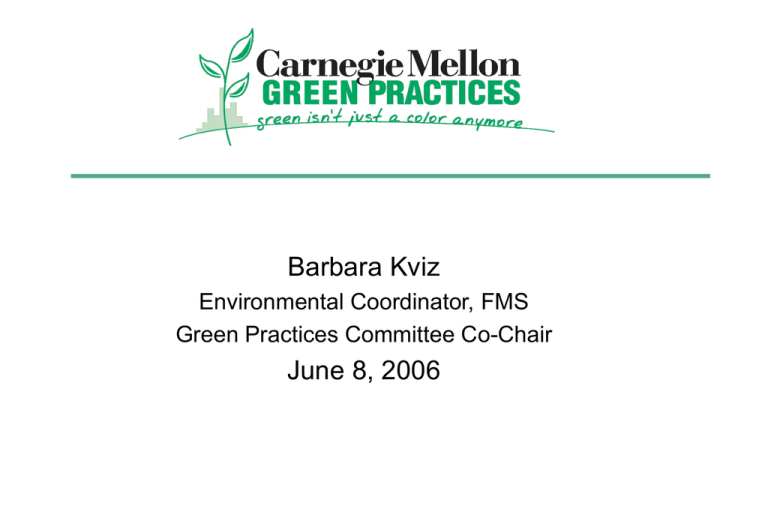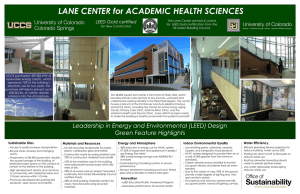Barbara Kviz June 8, 2006 Environmental Coordinator, FMS Green Practices Committee Co-Chair
advertisement

Barbara Kviz Environmental Coordinator, FMS Green Practices Committee Co-Chair June 8, 2006 OUTLINE • Green Practices at Carnegie Mellon – Why – What – How • Hamerschlag Hall green roof performance assessment • Cost implications of LEED silver certification for New House residence hall GREEN PRACTICES MISSION Strive to develop university practices that improve environmental quality, decrease waste, and conserve natural resources and energy REASONS FOR GREEN PRACTICES PROGRAM • Credibility for green practices and management techniques we develop and espouse • Opportunities for green design research and education activities to use campus as experimental or demonstration site • Universal environmental education for campus community • Save money and have environmental benefit GREEN PRACTICES COMMITTEE MEMBERS • • • • • Faculty and staff Undergrad and grad students Student environmental groups EHS FMS: Operations Manager, Energy Manager, Grounds Manager, University Engineer • Housing, Dining, Purchasing, Transportation FOCUS AREAS • • • • • • • Transportation Energy Built Environment Purchasing Landscape/Outdoor Environment Outreach and Marketing Waste Management/Dining Services Campus assessment completed in 2005 and available at www.greenpractices.org CAMPUS LIFE • Dining Services – reduce waste volume; use opportunity for environmental education • Waste Management – recycling, including e-waste; hazardous waste management • Procurement – develop criteria and guidelines • Communication – internal and external; develop Environmental Center on campus • Awards – student projects; Carnival booths FACILITY INFRASTRUCTURE • Building renovation and construction – University commitment to LEED certification for new buildings and renovations – Partnered with green building design group (CBPD) in Architecture • Landscaping – low maintenance campus gardens; native plants – environ. progressive landscaping designs in campus master planning effort CENTER FOR BUILDING PERFORMANCE AND DIAGNOSTICS An NSF Industry-University Cooperative Research Center (IUCRC) Intelligent Workplace The goals of the IW™ are to provide: •User comfort and satisfaction •Organizational Flexibility •Technological Adaptability •Environmental Sustainability RAIN GARDENS A drop of water that falls onto CMU’s campus has an average residency of 4 minutes before it reaches a drain. TRANSPORTATION • County bus system passes • Partnered with U.Pitt/UPMC in their carpool program • Established more flexible parking permits that encourage increased bus use • Shifting university vehicle fleet to CNG and other alternative fueled vehicles • Biodiesel use in shuttle buses ENERGY MANAGEMENT • Renewable energy: use wind power for 8% of our electricity and other renewable sources for additional 7% • Converted campus heating system to 50% natural gas supply • Photovoltaic power supply for new computer science facility 12kW DC • Developing long-term energy management plan COMMUNICATION • • • • • Univ. Center “Green Room” Dining Hall placards, table tents “Green Scene” newsletter Web site: www.greenpractices.org “Energy Day”, “Recycle Mania”, and other campus events • Campus art projects • Campus environmental center (solar house) E C O A R T Pittsburgh Synergy 2005 The Pittsburgh Solar Decathlon house, "Pittsburgh Synergy,“ is a joint entry by four area schools - the Carnegie Mellon Schools of Architecture and Design, University of Pittsburgh School of Engineering, and the Art Institute of Pittsburgh. COMMUNITY OUTREACH • SW PA Household Hazardous Waste Task Force • Food Composting Pilot Project • Pennsylvania Consortium for Interdisciplinary Environmental Policy (PCIEP) • College and University Recycling Council (CURC-NRC) • Professional Recyclers of PA GREEN ROOF MONITORING SYSTEMS FOR RUNOFF RETENTION PERFORMANCE ASSESSMENT D. Carothers, M. Snyder, R. Kung, K. Sew, D. Dzombak, C. Davidson sponsored by PADEP Energy Harvest Program 3 Rivers Wet Weather Demonstration Program Monitoring Areas GW1 GW2 = Roof Drain = Roof Drain w/ Flume CW1 HAMERSCHLAG HALL GREEN ROOF Control Roof SUMMARY • Methods being developed for assessing performance of green roofs for stormwater runoff rate/volume mitigation • Stormwater monitoring systems being developed for two flat green roof projects in Pittsburgh • Project will result in a green roof stormwater monitoring manual COST IMPLICATIONS OF LEED SILVER CERTIFICATION FOR NEW HOUSE RESIDENCE HALL N. Stegall and D. Dzombak full report available at www.greenpractices.org OBJECTIVES • Identify cost differences associated with LEED features for New House compared with what would have been done conventionally at Carnegie Mellon • Determine portion of total project cost associated with LEED features and certification METHODS • Inventoried LEED credits and associated labor, material, equipment • Discussed LEED features with project mgr, architects, mechanical eng, contractors to determine difference with “typical” CMU building • For each LEED feature, evaluated extra cost and compiled high/low estimates • Performed DOE2 model energy simulations to investigate energy savings, and effect of various energy-saving components NEW HOUSE GREEN FEATURES (35 LEED points out of 69 possible) LEED Points by Category 1 5 Sustainable Sites 2 13 Water Efficiency Energy & Atmosphere Materials & Resources 7 Indoor Environmental Quality Innovation & Design 7 LEED COST BREAKDOWN Area of Extra Cost Low Estimate High Estimate Larger trees for landscaping $4,120 $4,120 PVC Roof $6,750 $13,500 $0 $50,000 $16,000 $17,000 $0 $23,000 Additional Commissioning $5,827 $15,000 Certified Wood $4,060 $19,817 $25,000 $100,000 $1,500 $1,500 Filters $8,000 $8,000 Labor $13,520 $13,520 Building Systems Commissioning Measurement & Verification Equip Optimize Energy Performance AHU for Indoor Air Quality goals CO2 Monitors Construction IAQ plan LEED COST BREAKDOWN Area of Extra Cost Low Estimate Low Emitting Paints High Estimate $4,190 $4,190 $355 $355 Low Emitting Composite Wood $4,060 $4,816 Humidity Sensors $1,500 $1,500 Humidifier $8,000 $8,000 LEED Certification $1,800 $1,800 $25,000 $61,000 $129,682 $347,118 Low Emitting Adhesives/Sealants LEED Documentation Totals LEED COST PREMIUM Total project cost: $12,550,000 Total extra cost for LEED: $129,682 - $347,118 Total LEED premium: 1.0 – 2.8% Total construction cost: $10,050,000 Total extra cost for LEED: $97,055 - $196,318 Total LEED premium: 0.97 – 1.95% SUMMARY – CAMPUS GREEN PRACTICES • Means of campus-wide environmental education • Define and model sustainable practices • Provides opportunities for use of campus as experimental/demonstration site • High-level university support critical • Involvement of facilities group is critical RESOURCES • Carnegie Mellon Green Practices http://www.greenpractices.org/ • Green Building Alliance http://www.gbapgh.org


